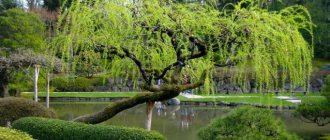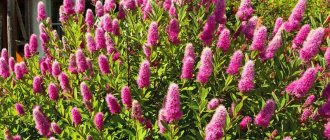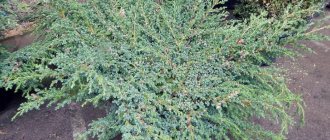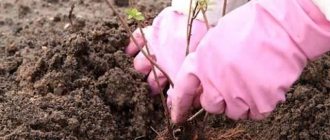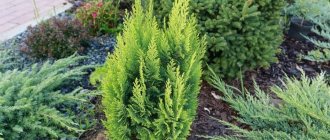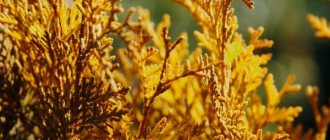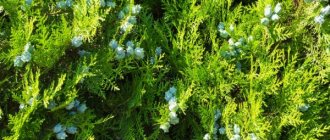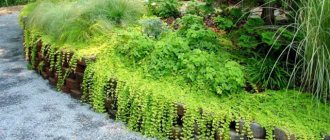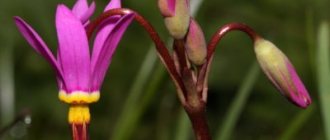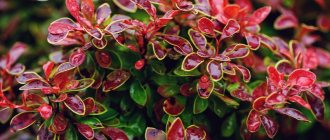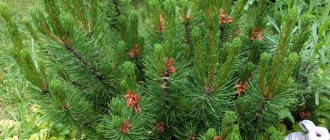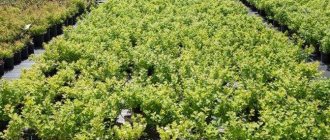The hemlock genus has been known in culture since the 18th century. It has up to two dozen species of trees, but even single-species representatives can have significantly different crown shapes and heights.
Most specimens reach 28-30 m, although some varieties grow up to 75 m. Under natural conditions, representatives of the genus grow in North America and East Asia, but since their appearance in Europe, trees have gained popularity in park landscaping.
The most popular cultivated species is the Canadian hemlock (Tsuga canadensis), native to the eastern regions of North America and Canada. The plant tolerates the climatic conditions of the middle zone well, since its varieties are quite resistant to low temperatures.
Features of Canadian hemlock
In natural conditions, Canadian hemlock can reach more than 20 m in height and up to 8 m in width. Its loose, spectacular crown has a conical shape. Often such a plant forms multi-stage forms. Its shoots are graceful and thin. The lateral and apical shoots have drooping tips. The branches located below of the Canadian hemlock can be so powerful and thick that it may seem like a multi-trunked tree.
Spindle-shaped cones are formed on the branches, which reach a length of about 25 mm. During the first year, the cones mature, and they fly around only in the second year of their growth. The flattened leaf blades can be colored in various shades from greenish-yellow to glossy green. On the underside of the foliage there are 2 white stripes, which include several stomatal lines.
This culture is unpretentious and has low maintenance requirements. It needs to be planted and grown in almost the same way as other coniferous plants. This species has a large number of ornamental varieties that differ in crown shape, growth type, leaf color and height.
Botanical description
Brief description of hemlock Pendula:
- size: height 2.8–3.5 m, diameter from 2 to 3 m;
- crown: tent-shaped, cushion-shaped or cascading;
- needles: dark green, shiny, dense;
- cones: oval, length from 1.5 to 2 cm, light brown;
- climate: humid, cool, well suited for darkened gorges and cold plains (as in Canada);
- insolation: in the open sun drying out or “spring” burns may occur; partial shade is better;
- soil: slightly acidic or neutral;
- development features: can grow tied to a support or with a graft on a trunk.
Planting hemlock in open ground
Selecting a location
Canadian hemlock takes root extremely poorly after transplantation. That is why experienced gardeners advise immediately choosing the most suitable site for it, so as not to move the bush to another place later.
This coniferous crop grows best in soil rich in organic matter, which drains water well but is evenly moist. Its pH level can be neutral or acidic. A suitable location should have reliable protection from the scorching rays of the midday sun and powerful gusts of wind. However, if hemlock grows in a region with a cool climate, then it is not harmed by direct sunlight during the day.
Landing Features
The planting hole must have such a depth that the roots of the seedling, taken together with a lump of earth, can freely fit into it. When planting the plant, make sure that the root collar rises slightly above the ground level.
When digging a hole, the top layer of soil must be removed separately. This soil is mixed with a small amount of compost, peat and sand, which increases its drainage. Expanded clay or coarse sand should be laid at the bottom of the prepared pit in a 15 cm layer.
Planted seedlings need to be watered with plenty of water. In order to prevent excessive evaporation of moisture, the surface of the soil near the bush must be covered with a layer of mulch (finely broken bark or peat). This will also help prevent the root system from overheating.
There is no special need to apply any fertilizers to the tree trunk circle, since the tree has enough nutrients that it receives from the mulch layer and its fallen needles.
Canadian hemlock from OBI, planted on an alpine hill
Using hemlock in garden design
Hemlock is an excellent choice for elegant, eye-catching accents. The grace and texture of its crown, bending to the ground thanks to drooping shoots, gives the garden a special atmosphere. The shoots of hemlock are elegant, but visually it cannot be called light: thanks to the density of the needles, it seems luxuriously dense, fabric-textured, and the low forms look almost carpet-like.
Bright, catchy accents of hemlocks in small gardens should be used wisely, compensating with openwork neighbors or skillfully playing on the perception of space through the choice of color. And, of course, you need to carefully select varieties and shapes, the sizes of which are consistent with the area of the site.
Hemlock is one of the best evergreen plants for decorating the lawn, ponds, placed alone or in a group. But there is no need to be afraid to use the beauty of its silhouettes and small scattering of cones in ensembles:
- enter into front gardens;
- mix with other coniferous and deciduous shrubs in small groups with a combination of different shapes and sizes;
- add large accents to landscape flower beds and thickets;
- create unusual edges;
- use for rockeries and rock gardens with ponds;
- decorate heather gardens;
- create an original border;
- bring the effect of green cascades in compositions with complex terrain, near stairs, in terraced gardens.
Planting hemlocks near water bodies is the best option in terms of simplifying care, because this way, moisture-loving hemlocks will not suffer from dry air and will require less watering.
This is one of the most effective shaders, creating dense shade and camouflage of conifer species to create “secret corners”.
Hemlock in garden design. © princely-garden
Caring for hemlock
Watering
Hemlock responds very poorly to drought, so it must be systematically watered during long dry periods. Particular attention should be paid to watering a young plant. If the bush does not have enough moisture, this can cause stress: the needles turn yellow, and the branches droop.
Until the bush grows and gains strength, it is watered at least once every 7 days during the dry period. At the same time, it is recommended to sprinkle it with a hose at least once every 30 days during the hot summer months. It is recommended to loosen the surface of the soil in the tree trunk circle only if it has become very dense. In this case, the soil should be loosened at a depth of no more than 10 centimeters.
Wintering
Adult hemlock is characterized by fairly high frost resistance. However, the tops of young stems of seedlings may freeze in winter. In order to avoid this, young bushes are covered with agrofibre or spruce branches in late autumn. It is also recommended to cover the surface of the tree trunk with a layer of mulch (spruce branches or compost), which will provide reliable protection to the root system from excessive evaporation and severe frosts if the winter has little snow.
Fertilizer
Hemlock feeding is carried out only if necessary. It is carried out in the spring before young shoots appear. To do this, use a mineral complex fertilizer for coniferous plants.
Planting process
Semi-shaded, windless, environmentally friendly places are suitable for growing. Fresh, moist, acidified, well-drained, fertile soil is optimal. The best time for planting is considered to be the first two weeks of May and August. The depth of the planting hole should be at least twice the length of the roots of the seedling. Optimal - at least 70 cm.
The landing pattern looks like this:
- To ensure good drainage, the bottom of the pit is covered with a 15 cm thick layer of sand. The sand is pre-washed and calcined.
- The hole is filled with a soil mixture of turf soil, leaf soil and sand in a ratio of 2:1:2. Sometimes a mixture of compost and garden soil is used in a 1:1 ratio.
- A seedling with a lump of earth is lowered into the hole.
- The root system is sprinkled with soil, without touching the zone of transition of the roots into the trunk.
- The seedling is watered abundantly (about 10 liters of water for each hole) and the soil is mulched with gravel, bark or wood chips.
When planting in groups, take into account the distance between the holes. Normally it should be 1.5-2.0 m.
In the first 24 months, the seedlings are protected from the wind; they are unstable due to the poor development of the root system. Young plants are more sensitive to frost than their mature counterparts.
To grow and develop, hemlock requires regular watering at the rate of ≈10 liters of water every week per 1 m². Spraying the crown once a month is useful. The plant should be fed in autumn and spring, using no more than 200 g of compost per 10 liters of water.
Hemlock loves phosphorus and potassium fertilizers, but does not tolerate nitrogen fertilizers.
It is recommended to cut branches touching the ground to avoid rotting. Loosening is best done when the soil is heavily compacted, no deeper than 10 cm.
Caring for hemlock in the Moscow region has its own characteristics. Before the onset of cold weather, the plant should be covered with spruce branches or peat. Snow needs to be cleared from the branches to prevent them from breaking.
Reproduction methods
Growing from seeds
You can buy Canadian hemlock seed material at a nursery. Also, if you wish, you can assemble it with your own hands. To do this, in the autumn, pick the cones from an adult plant and put them in a well-lit or warm place, where they should open after a while. Before sowing seeds, they should be stratified. To do this, they are put away on the refrigerator shelf for 2–2.5 months.
Sowing of the prepared seed material is carried out in a moistened soil mixture consisting of one part of peat and the same amount of universal soil. They need to be buried into the substrate to a depth of 0.3 to 0.4 cm. Move the crops to a well-lit place (the light should be diffused) and make sure that the soil mixture in the container is always a little damp.
Planting of seedlings grown from seeds in open ground is carried out in August. This procedure can be postponed until next spring. The planted plants are systematically watered during the first three years and do not forget to cover them for the winter.
Cuttings
The cuttings are harvested in the last weeks of the summer. For this, shoots of the current year are used, which should be semi-lignified. At the top the bark should be colored green, and near the cut - brown. In order for the cuttings to quickly take root, all needles are removed from their lower part and treated with a powder that stimulates plant growth, which is suitable for trees and woody shrubs.
Inspect the cut of the cutting; it must be covered with a layer of powder. After this, it can be planted in a container filled with soil mixture. Take a pot of suitable size and make a good drainage layer at the bottom. Then fill it with a substrate consisting of soil and sand (or perlite). Water the planted cuttings generously and place it along with the pot in a bag that should be transparent. Watering the section is carried out as the top layer of the soil mixture dries. Rooted cuttings are planted in a permanent place in the last weeks of spring.
Types and varieties of garden hemlocks
There are a little more than a dozen species in the Tsuga genus; only one plant is grown in the middle zone. But its decorative forms are very diverse.
Canadian hemlock (Tsuga canadensis) is a beautiful decorative species with a wide cone-shaped crown and horizontally growing branches hanging at the ends. Flat needles up to 1.5 cm in length and small, numerous, brownish cones seem stunningly elegant. Trees in nature up to 25 m high in gardens are presented in more compact forms:
- “Minute” (Minuta) is a half-meter compressed dense form;
- "Minima" - a two-meter round shape with short branches;
- "Pendula" - weeping, wide-spreading, uneven form;
- "Parviflora" - dwarf, elegant form with elongated lines;
- "Aurea" - a squat golden form that turns green towards the end of the season;
- "Macrophylla" - straight, large-needle-shaped, fast-growing hemlock;
- "Microphylla" - a species with shortened needles and very light, airy branches;
- “Prostrata” - a low form creeping along the ground;
- “Albospicata” - graceful, up to 2 m in height, loose pyramidal hemlocks with yellowish young needles and colored tips of shoots;
- "Hussie" (Hussii) - low, squat-round, very bushy form;
- "Nidiformis" - dwarf fan-shaped form;
- "Dwarf" - a wide pin-shaped form with hanging shoots;
- "Nana" - a meter-long hemlock with horizontal shoots;
- "Nana Gracilis" - a dwarf, densely branching, weeping plant;
- "Gracilis" (Gracilis) - graceful form with hanging branches, bending arches;
- "Gracilis Oldenburg" (Gracilis Oldenburg) - a dwarf up to 25 cm high (at 10 years old) with nest-like depressions in the crown and hanging shoots;
- “Compacta” - dwarf, up to 1 m, bushy-spreading form;
- "Jeddeloh" is a semicircular dwarf with spirally arranged, funnel-shaped branches.
Canadian hemlock (Tsuga canadensis), form “Minute” (Minuta). © Jaroslav Solc
Canadian hemlock (Tsuga canadensis), form “Nana Gracilis”. © Conifers2
Canadian hemlock (Tsuga canadensis), form “Jeddeloh”. © FD Richards
Diseases and pests
Diseases
Most often, Canadian hemlock is affected by fungal diseases. This can happen due to increased air humidity with poor ventilation, and also due to stagnation of fluid in the roots of the plant. The leaves of the affected tree turn yellow and die, and the tops of young shoots dry out. Hemlock is also susceptible to rust. Because of it, a rusty growth forms on the surface of the needles and cones, which contains fungal spores.
To save diseased specimens, they need to be sprayed several times with a solution of a fungicidal drug. If possible, cut off all affected parts and destroy them.
Pests
The following pests can live on hemlock: aphids, caterpillars, spider mites and scale insects.
Canadian hemlock. Conifers of the Moscow region, continued.
Landing
Successful selection of soil, its enrichment and timely planting in general will help the gardener ensure the decorative properties of Canadian hemlock throughout the year. The main conditions are light moisture, the presence of drainage, and a neutral soil composition. The best time to plant a tree is mid-spring or autumn.
April and September in Russia provide ideal conditions for the tree to take root and grow actively. Planting near a pond will provide the tree with a sufficient level of moisture. Semi-shaded areas are perfect for the plant because of its love for moderate light without an abundance of direct sunlight.
Preparing the site
First of all, check the soil pH: if the acidity is high, neutralize it. Afterwards, you need to dig a planting hole 80 cm deep. The width may vary depending on the variety, but should be 20 cm larger than the hemlock root system. Place drainage at the bottom.
It is recommended to add fertilizer that includes peat and compost.
Selection of seedlings
Considering that it is problematic to find hemlocks in the natural environment, and therefore cones with seeds, gardeners buy seedlings. They must be in containers.
Carefully examine the seedling before purchasing : the height of the largest varieties should not exceed half a meter. Inspect the branches : they should have a bright color with a color characteristic of a particular type of hemlock. The root system should be sprouted and not crumpled into a single ball.
Step-by-step instruction
The process of planting a hemlock seedling should begin with the root covered.
You must act according to the following algorithm:
- Expand the root system.
- Place the seedling in the center of the planting hole.
- Add fertilizer to the soil.
- Water in the amount of 1 bucket of water per unit of planting material.
- Mulch the soil, for example with grass clippings.
When planting several trees, consider the distance between them. The interval should be about 2 m so that both plants do not interfere with each other's growth and also grow well in width.
Canadian hemlock in landscape design
Hemlock is a shade-loving crop, so it can be grown in the shade. It will look great next to other shade-loving plants, for example, it can be planted near Rogers, ferns, hostas, wintergreens, etc.
Since the plant has a spectacular openwork crown and drooping branches that touch the soil surface, it can be grown both as a solo crop and together with spectacular flowering plants.
Ground cover dwarf varieties are suitable for growing on alpine hills or rockeries. Since the tree loves high humidity, it can be planted near an artificial pond. Please note that wetlands are not suitable for growing it.
Since this is a slow-growing crop, it will fit perfectly into any garden. The fact is that hemlock does not need to be cut regularly, and it ages very slowly.
Description of the plant
Hemlock is one of the most spectacular, slow-growing and elegant species of conifers, with which you can transform and decorate your garden. And it is no coincidence that it has become a plant with a special status. Hemlocks stand out clearly against the background of other conifers, even in nature. When comparing hemlock with spruce or fir in terms of decorativeness, they are being a little disingenuous. Thanks to its shortened, flat needles and thin shoots drooping at the ends, hemlock has a more textured and strikingly graceful appearance.
All hemlocks are monoecious evergreen trees with a pyramidal-cone-shaped, ovoid, slender crown. Only after 50-60 years do hemlocks sometimes become unevenly wide and loose. Deeply furrowed brown bark adorns the trunk, but it is difficult to see under the thick needles. The shoots grow horizontally, they are thin and densely branched. Their graceful ends droop beautifully. The graceful branches appear unusual, their lines creating lacy and feather-like patterns and enhancing the textural effect of the greenery.
The needles on hemlock branches are very dense. Flattened, short, only up to 1.5 cm in length, single needles with whitish stripes on the underside can be either whole or finely toothed along the edge, narrowed at the base into a short petiole, and sit on unusual hook-shaped protrusions. Hemlock buds are very small.
The cones, which ripen by the end of the first year but do not fall off until the second, are medium-sized, neatly ovoid, and seem like a decorative scattering of decorations against the background of the dense crown. The grayish-brown color only emphasizes their unusualness.
Hemlocks grow very slowly, adding 10-15 cm per year even in the fastest growing forms.
Canadian hemlock (Tsuga canadensis). © zahradnictvogreen
Varieties of Canadian hemlock with photos
Albospica
They began cultivating this variety in 1866. The low-growing tree is decorated with long dark green needles with snow-white tips. Experts recommend using it to decorate shaded areas in the garden.
Jeddeloh
The shape of the crown of the shrub is hemispherical, and it is characterized by slow growth. The plant reaches only about 50 cm in height, and it is one of the shortest varieties of Canadian hemlock. Due to the fact that the stems grow radially, a characteristic depression is formed in the middle of the bush. The soft needles are dark green.
Pendula
This beautiful tree has weeping stems that hang so low that they reach the surface of the soil.
Cole's Prostrate
This spectacular ground cover shrub grows low, its cascading lush branches form a cushion-shaped crown. New needles grown in spring have a light green color, while mature leaves are dark green.
Sargentii
A large tree grows a large number of drooping stems. Its height is about 3 meters, and its diameter reaches 6 meters.
Wintergold
This rare variety has needles of a golden hue, and its crown has an elegant pyramidal shape. The tree reaches a height of about 200 cm. Around October, the needles turn golden and remain that way until mid-spring (until April). In order for the color of the needles to be saturated, the tree should be planted in a well-lit area.
Moon Frost
The variety is represented by a compact dwarf tree. Its characteristic feature is the snow-white tips of new shoots that appear in spring. However, in the summer, all the needles turn green.
Gentsch White
This dwarf variegated shrub can reach a height of about 100 cm. Its crown shape is cushion-shaped. The tops of the graceful thin shoots are white and cream. In the autumn-winter period, their shade becomes more saturated, thereby increasing the contrast between the mature dark green needles. To maintain the high decorativeness of the shrub, experts advise pruning it every year. Thanks to this, young shoots will grow more intensively.
Coniferous plants for the garden Pine, hemlock. Website "Garden World"
Popular varieties
Based on Canadian hemlock, several popular varieties have been developed that are widely used in garden design. Beautiful needles, an unusually shaped crown and high vitality have made them extremely popular.
Hemlock Nana
A low-growing compact tree 1-2 m high prefers sandy or clayey rocky areas. The crown is rounded, horizontal shoots are directed downwards. Young bright green, smooth and shiny needles up to 2 cm long gradually become dark green. The variety is frost-resistant and can even tolerate deep shade.
Hemlock "Jeddeloh" (Tsuga canadensis Jeddeloh)
The hemispherical shrub differs from others in its extremely slow growth and purple-gray bark. Rightfully included among the shortest representatives of the “Canadians”. Its height rarely exceeds 50 cm. Radial branches form a depression in the middle part, typical for this variety. The color of the needles is dark green.
Hemlock Iceberg
The crown of this variety has a pyramidal shape, very openwork, with weeping branches. The height does not exceed 1 m. The needles are dark green with a bluish tint and a waxy coating. Like other Canadian varieties, it loves shade, as well as loose, fertile, abundantly moist soil.
Hemlock Popeleski
A dwarf plant with a flat-spread crown, which takes on a dome-shaped appearance as it grows. A tree at 10 years old has a height of up to 40 cm and a diameter of 50-60 cm. Short green needles have shine and a brighter color on annual shoots. Prefers partial shade, protected from winds. Winter hardiness of the variety is down to -23 °C.
Hemlock Pendula (Pendula)
The tree, about 3.8 m tall, has several trunks and a weeping crown formed by skeletal, drooping branches that touch the ground. The dark green shiny needles have a noticeable bluish tint. The variety is grown as an independent tree, but quite often it is grafted onto a standard to obtain an unusually shaped crown.
Hemlock (Jervis)
A dwarf tree that rarely grows above 1 m. It is distinguished by an unusually high crown density. Densely growing shoots are directed straight upward. The color of the needles is dark green. Feels great in the sun, partial shade and shade. The variety is sensitive to air humidity and prefers high humidity. Winter hardiness – up to -29 °C.
Hemlock "Cole's Prostrate" (Tsuga Canadensis Cole's Prostrate)
A low-growing shrub, reaching a height of only 10 cm by the age of 10 years, but spreading branches 80 cm wide. The cushion-shaped ground cover produces spring growth of a bright green color, gradually darkening to gray-green. It is usually planted along retaining walls and on rocky hills. Prefers sunny areas, frost resistance - down to -29 ° C.
Canadian hemlock Gentsch White
A low tree or shrub about 1.5 m tall has a spreading, round, loose crown. The annual growth does not exceed 15 cm. The needles that bloom in spring are colored creamy-white, the next year they become gray-green, and in subsequent years they turn into dark green. The variety tolerates shaping haircuts well and prefers shady and semi-shaded areas.
Features of planting and care
Well-drained fertile soil with a high content of nutrients and neutral acidity is suitable for planting Jeddeloch hemlock. It does not like limestone soil - it develops poorly on it and produces weak growth. To create drainage, use a mixture of sawdust and sand in equal quantities. Planting is carried out in mid-spring - throughout the summer. The location is chosen according to the characteristics of the bush. Feels good near bodies of water.
Features of keeping and caring for Canadian hemlock:
- It is necessary to constantly keep the soil moist, but not allow water to stagnate. During dry periods, additional watering will be required.
- Doesn't like transplantation.
- The root zone is mulched with organic material.
- Reacts well to sprinkling along the crown.
- Does not require pruning of shoots.
- The root system extends parallel to the soil surface. This feature should be taken into account when creating combined compositions.
- The shrub responds positively to additives that increase soil fertility. During the first time after planting, moderate feeding is required.
